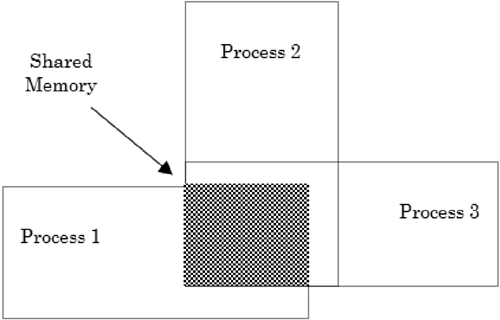Introduction
Shared memory allows multiple processes to share virtual memory space. This is the fastest but not necessarily the easiest (synchronization-wise) way for processes to communicate with one another. In general, one process creates or allocates the shared memory segment. The size and access permissions for the segment are set when it is created. The process then attaches the shared segment, causing it to be mapped [1] into its current data space. If needed, the creating process then initializes the shared memory. Once created, and if permissions permit, other processes can gain access to the shared memory segment and map it into their data space. Each process accesses the shared memory relative to its attachment address. While the data that these processes are referencing is in common , each process uses different attachment address values. For each process involved, the mapped memory appears to be no different from any other of its memory addresses. Figure 8.1 presents a diagrammatic way to envision three processes sharing a common memory segment. As there are no intrinsic shared memory synchronization constructs, semaphores are normally used to coordinate access to a shared memory segment. When a process is finished with the shared memory segment, it can detach from it. Additionally, the creator of the segment may grant ownership of the segment to another process. When all processes are finished with the shared memory segment, the process that created the segment is usually responsible for removing it.
[1] The actual mapping of the segment to virtual address space is dependent upon the memory management (MMU) hardware for the system.
Figure 8.1. Envisioning three processes sharing a common memory segment.

Programs and Processes
- Introduction
- Library Functions
- System Calls
- Linking Object Code
- Managing Failures
- Executable File Format
- System Memory
- Process Memory
- The u Area
- Process Memory Addresses
- Creating a Process
- Summary
- Key Terms and Concepts
Processing Environment
- Introduction
- Process ID
- Parent Process ID
- Process Group ID
- Permissions
- Real and Effective User and Group IDs
- File System Information
- File Information
- Process Resource Limits
- Signaling Processes
- Command-Line Values
- Environment Variables
- The /proc Filesystem
- Summary
- Key Terms and Concepts
Using Processes
- Introduction
- The fork System Call Revisited
- exec s Minions
- Using fork and exec Together
- Ending a Process
- Waiting on Processes
- Summary
- Key Terms and Concepts
Primitive Communications
- Introduction
- Lock Files
- Locking Files
- More About Signals
- Signal and Signal Management Calls
- Summary
- Key Terms and Concepts
Pipes
Message Queues
- Introduction
- IPC System Calls: A Synopsis
- Creating a Message Queue
- Message Queue Control
- Message Queue Operations
- A ClientServer Message Queue Example
- Message Queue Class
- Summary
- Key Terms and Concepts
Semaphores
- Introduction
- Creating and Accessing Semaphore Sets
- Semaphore Control
- Semaphore Operations
- Semaphore Class
- Summary
- Key Terms and Concepts
Shared Memory
- Introduction
- Creating a Shared Memory Segment
- Shared Memory Control
- Shared Memory Operations
- Using a File as Shared Memory
- Shared Memory Class
- Summary
- Key Terms and Concepts
Remote Procedure Calls
- Introduction
- Executing Remote Commands at a System Level
- Executing Remote Commands in a Program
- Transforming a Local Function Call into a Remote Procedure
- Debugging RPC Applications
- Using RPCGEN to Generate Templates and a MAKEFILE
- Encoding and Decoding Arbitrary Data Types
- Using Broadcasting to Search for an RPC Service
- Summary
- Key Terms and Concepts
Sockets
- Introduction
- Communication Basics
- IPC Using Socketpair
- Sockets: The Connection-Oriented Paradigm
- Sockets: The Connectionless Paradigm
- Multiplexing I/O with select
- Peeking at Data
- Out of Band Messages
- Summary
- Key Terms and Concepts
Threads
- Introduction
- Creating a Thread
- Exiting a Thread
- Basic Thread Management
- Thread Attributes
- Scheduling Threads
- Using Signals in Threads
- Thread Synchronization
- Thread-Specific Data
- Debugging Multithreaded Programs
- Summary
- Nomenclature and Key Concepts
Appendix A. Using Linux Manual Pages
Appendix B. UNIX Error Messages
Appendix C. RPC Syntax Diagrams
Appendix D. Profiling Programs
EAN: 2147483647
Pages: 136
